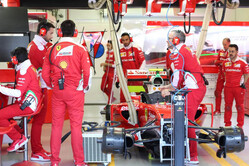Formula 1 (F1), widely considered the pinnacle of motorsport, has always been associated with speed, innovation, and cutting-edge technology.
However, it also carries a significant environmental impact, with its carbon footprint under scrutiny. Each race season involves high-emission activities such as global travel, energy-intensive car manufacturing, and fuel consumption. It's estimated that F1's carbon footprint amounts to around 256,000 tons of CO2 annually, with the bulk of it (approximately 45%) coming from logistical operations such as transporting teams, cars, and equipment across continents.
In recent years, growing environmental concerns and societal pressure have led F1 to rethink its approach to sustainability. In 2019, Formula 1 launched an ambitious sustainability plan, aiming to become carbon neutral by 2030. This plan includes reducing emissions across all areas of the sport, from the cars and fuel used to the energy powering the events themselves. It's a bold initiative, particularly for a sport so reliant on fossil fuels and global logistics.
Current efforts include transitioning to hybrid engines, the use of renewable energy sources at racetracks, and encouraging teams to adopt sustainable practices. For instance, the 2026 power unit regulations will focus on increasing efficiency while making the cars even more dependent on electric power. While this is a significant step forward, the journey to sustainability in F1 is far from complete, much like how finding a list of Canadian online casinos with 1 dollar deposits offers players convenient access but still leaves room for improvement in the gaming industry.
 Hybrid engines and beyond
Hybrid engines and beyond
One of the most visible sustainability efforts in F1 has been the introduction of hybrid power units, starting in 2014. These engines, which combine a traditional internal combustion engine (ICE) with energy recovery systems (ERS), represent a step toward reducing the sport's reliance on fossil fuels. The hybrid era has seen F1 engines become significantly more fuel-efficient, with current cars using 35% less fuel than they did before 2014 while still achieving similar or better performance levels.
The hybrid engines work by recovering energy from two primary sources: braking (via the kinetic energy recovery system, or KERS) and heat (through the heat energy recovery system, or HERS). This recovered energy is stored in batteries and used to supplement the power provided by the ICE. Not only does this make F1 cars more fuel-efficient, but it also allows for a reduction in emissions during races.
Looking ahead, F1 is committed to adopting 100% sustainable fuel by 2026. This synthetic fuel will be made from renewable sources and designed to work seamlessly with internal combustion engines. Additionally, F1 continues to explore how electric and hydrogen technologies could influence future power units. While fully electric F1 cars may not be viable in the near term due to performance and range limitations, combining hybrid, electric, and alternative fuel technologies will likely be the key to the sport's long-term sustainability.
Table: Progression of F1 engines towards sustainability
|
|
|
|
|
|
Year
|
Engine Type
|
CO2 Emissions Reduction (%)
|
Fuel Efficiency Increase (%)
|
|
Pre-2014
|
V8 Internal Combustion
|
Baseline
|
Baseline
|
|
2014-2024
|
V6 Hybrid Power Unit
|
30%
|
35%
|
|
2026 (planned)
|
V6 Hybrid + Sustainable Fuel
|
50%
|
50%
|
Sustainable materials
F1 teams are also beginning to focus on using sustainable materials in constructing cars and equipment. Traditionally, F1 cars are built with high-performance but resource-intensive materials like carbon fiber and titanium. While these materials are essential for maintaining the lightweight and durable properties needed for racing, they come with a hefty environmental cost due to the energy-intensive production processes involved.
To mitigate this, F1 teams are investigating alternative materials that provide similar performance benefits while being more eco-friendly. One area of interest is the development of biodegradable composites made from natural fibers, which could potentially replace certain carbon fiber components. In addition, research into recycling and reusing carbon fiber parts is gaining traction, with some teams already beginning to implement these practices to reduce waste.
Furthermore, F1 has started promoting the use of sustainable clothing and equipment for both the teams and fans. Companies that produce team gear and merchandise are now working with materials like organic cotton and recycled polyester, reducing the ecological impact of fan apparel and team kits. These efforts extend beyond the racecars themselves, contributing to a more holistic approach to sustainability within the sport.
Eco-friendly racing circuits
Racetracks and racing circuits, as the central stage for F1 events, are also critical to the sport's sustainability efforts. Many circuits have recognized the need to reduce their environmental footprint and have taken steps to implement greener practices. The Circuit de Barcelona-Catalunya, for instance, has become a leader in this area, achieving ISO 14001 certification for environmental management. This certification recognizes circuits that have developed comprehensive systems to monitor and reduce environmental impacts.
Many F1 circuits are now incorporating renewable energy sources to power facilities and reduce reliance on non-renewable energy, including:
• Solar panels, as seen at Silverstone Circuit in the UK, which have significantly cut carbon emissions.
• Wind turbines, which are being explored by several circuits as a renewable power source.
• Sustainable water management systems, like the one implemented at Paul Ricard Circuit in France, which reduce water waste and limit environmental impact.
Several circuits have also begun reforesting efforts, planting trees around their sites to act as carbon sinks and offset some of the emissions generated during races. Moreover, initiatives such as waste reduction, recycling programs, and water conservation are becoming commonplace in F1 venues, ensuring that these global sporting events leave a smaller ecological footprint.
 Public perception
Public perception
The perception of sustainability in F1 among fans and stakeholders is evolving. Historically, it has been seen as a fuel-guzzling sport with little regard for environmental concerns. However, as the sport has made significant strides toward becoming more sustainable, this perception is beginning to shift.
A growing number of fans, particularly younger ones, are becoming more environmentally conscious and expect F1 to take responsibility for its carbon footprint. Surveys conducted by the FIA (Federation Internationale de l'Automobile) suggest that up to 70% of F1 fans support the sport's sustainability initiatives, with many calling for even faster progress. Fans appreciate the technological advancements in hybrid engines, sustainable fuel, and eco-friendly circuits, seeing these changes as necessary for the sport's future.
Stakeholders, including sponsors and broadcasters, are also aligning themselves with sustainability goals. Brands that partner with F1 are increasingly focused on their own corporate social responsibility (CSR) agendas and view F1's sustainability initiatives as an opportunity to enhance their image. For example, Heineken, one of F1's major sponsors, has integrated sustainability into its campaigns, promoting responsible consumption and environmental consciousness at events.
Despite these positive developments, some critics argue that F1's efforts are still insufficient compared to the scale of the environmental crisis. They call for a faster transition to renewable energy and more aggressive carbon reduction measures. Nevertheless, the sport's growing emphasis on sustainability is being well-received overall, and this momentum will likely continue as F1 aims to meet its 2030 targets.
Wrapping up
Formula 1 is in a unique position to drive sustainability in motorsport and beyond. With its global reach and cutting-edge technology, F1 can set a powerful example for other racing series and industries to follow. The adoption of hybrid engines, sustainable fuels, eco-friendly materials, and green circuits showcases the sport's commitment to reducing its environmental impact.
While F1's carbon neutrality goal for 2030 is ambitious, it reflects a broader shift in motorsport toward more sustainable practices. As F1 continues to innovate, it will not only transform its own operations but also influence other sectors to adopt greener technologies and strategies. In doing so, Formula 1 can become a leader in the green revolution, paving the way for a more sustainable future in both motorsport and the wider automotive industry.






















